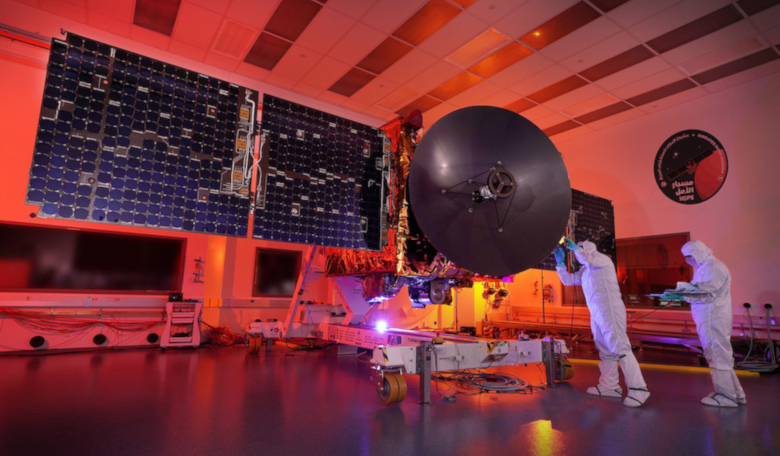If all goes well, tomorrow will mark an historic day for the United Arab Emirates (UAE) as the country, which is a relative newcomer to the space industry, is due to launch its first planetary-science mission to Mars.
Scheduled to launch from a remote Japanese island, Tanegashima, during a narrow launch window at 20:51:27 UTC/GMT on 14 July, the Emirates Mars Mission, or "Hope", will blast off on a seven month journey to the Red Planet.
Once in orbit, the probe will spend one Martian year, or about two Earth years studying the dynamics of the martian atmosphere, with a possibility of a two-year extension to do more science into 2025.
One of the primary scientific goals of the mission is to try and understand why Mars is losing its atmosphere by tracking the escape of hydrogen and oxygen with the Emirates Mars Ultraviolet Spectrometer (EMUS).
One of three instruments mounted on one side of the spacecraft, EMUS will also determine the abundance and variability of carbon monoxide in the thermosphere on sub-seasonal timescales.
Hope is also carrying a high-resolution multiband camera called the Emirates eXploration Imager (EXI). Designed to measure the planet's water ice and ozone abundances, it will focus on Mars’ lower atmosphere.
Finally, the Emirates Mars InfraRed Spectrometer (EMIRS), that was co-developed with Arizona State University, one of the project's three US partner universities, will investigate how the lower and upper levels of the martian atmosphere are connected in conjunction with EMUS and EXI observations.
EMIRS is also set to measure the global distribution of dust, ice clouds, water vapour and temperature profile of the martian skies.
Although Hope will not the be the first probe to collate data on the martian atmosphere, it differs from past missions such as NASA's Mars Atmosphere and Volatile Evolution (MAVEN) spacecraft, by focusing on observations at Mars’ equator;
Once at Mars, Hope is programmed to enter an elliptical, roughly 22000 x 44000 km orbit at the same inclination as Mars' axial tilt, 25 degrees, a prime viewing location that will assist the probe in investigating how conditions in the lower atmosphere change over time on the Red Planet.
"What this mission does is, it provides us a full understanding of the Martian atmosphere throughout the day," Sarah Al Amiri, science lead for the mission and the UAE's minister of state for advanced sciences, said during a news conference held on 9 July.
"So it covers all regions of Mars at all local times at Mars, and that's a comprehensive understanding that fills in the gap of changes through time through different seasons of Mars throughout an entire year."
The probe, which is presently stashed into the nose cone structure that protects the craft (the payload fairing) atop of a Mitsubishi H-IIA booster, will be powered by energy collected from solar panels which provide 600 Watts of power at Mars – the spacecraft requirement is 477 W.
Despite a gloomy weather forecast predicted for tomorrow, space officials, including the UAE Space Agency director-general and deputy project manager of the Emirates Mars Mission, are said to be attending the launch.
Meanwhile signs have been placed in popular viewing spots in Tanegashima, asking the public to keep a 3 kilometre distance from the space centre on launch day and the day after to comply with safety measures taken by officials to limit the risks posed by Covid-19.
Providing conditions do not hinder the launch and the probe makes it safely to Mars, Hope will arrive at the red planet in time for the 50th anniversary of the emirates’ independence.











